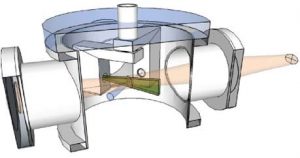People
Liam Duffy

Field: Physical Chemistry
Room: 416 Sullivan Science Building
Phone: 336.334.4604
Email: liam_duffy@uncg.edu
Research Website: https://chem.uncg.edu/duffy/
Education
B.A., Boston University, 1988
Ph.D., University of North Carolina Chapel Hill, 1995
NRC Research Associate, Duke University Physics, 1996-1999
Research
Molecular Reaction Dynamics Probed Via Pure Rotational Spectroscopy
My students and I have designed, built and tested a unique instrument for probing molecular reaction dynamics via pure rotational spectroscopy. The technique takes advantage of high frequency microwave sources in the millimeter and sub-millimeter wavelength region to probe the products of gas phase reactions. The ultimate goal of this research is to deduce the molecular electronic states involved in the transition state of a chemical reaction by measuring the speed, direction and internal energy of the products, much the same way an officer attempts to determine the cause of a car accident by studying the wreckage. Product molecules may be formed in a wide variety of rotational, vibrational, and electronic (rovibronic) states. Measuring and predicting these distributions is the primary way that physical chemists attempt to understand the nature the transition states of gas phase reactions. The ultrahigh resolution afforded by the microwave technology has allowed us to probe these product state distributions with unprecedented hyperfine detail.
 These sorts of experiments involve a variety of high-tech devices and tools including high powered lasers, oscilloscopes, vacuum chambers and pumps, supersonic molecular beams, as well as microwave sources and liquid helium cooled detectors. We have performed single molecular beam photodissociation experiments to emulate UV induced reactions implicated in ozone depletion and more recently we have begun crossed molecular beam experiments to study bimolecular reactions of reactive radical species such as excited oxygen (1D) atoms. We also have a tangentially related project to slow molecular beams using a microchip based Stark decelerator. We are designing this chip with the ultimate goal of producing ultracold molecules for the study of ultracold chemistry.
These sorts of experiments involve a variety of high-tech devices and tools including high powered lasers, oscilloscopes, vacuum chambers and pumps, supersonic molecular beams, as well as microwave sources and liquid helium cooled detectors. We have performed single molecular beam photodissociation experiments to emulate UV induced reactions implicated in ozone depletion and more recently we have begun crossed molecular beam experiments to study bimolecular reactions of reactive radical species such as excited oxygen (1D) atoms. We also have a tangentially related project to slow molecular beams using a microchip based Stark decelerator. We are designing this chip with the ultimate goal of producing ultracold molecules for the study of ultracold chemistry.
Representative Publications
Gabriele Santambrogio, Samuel A. Meek, Mark J. Abel, Liam M. Duffy, and Gerard Meijer, Driving Rotational Transitions in Molecules on a Chip, ChemPhysChem, Vol. 12, Issue 10, July 11, 2011, pages 1773-2043
Bobby H. Layne, Liam M. Duffy*, Hans A. Bechtel, Adam H. Steeves, and Robert W. Field, Beam Action Spectroscopy via Inelastic Scattering, Invited Article: Roger E. Miller Memorial Edition of Journal of Physical Chemistry A, 2007, 10.1021/jp0708650, *corresponding author
Liam M. Duffy , Photodissociation dynamics in “hyper-rovibronic” detail: exploring the potential of mm/submm-wave spectroscopy in molecular reaction dynamics experiments., Rev. Sci. Instrum., Vol. 76, 2 September 2005 , p. 093104.





